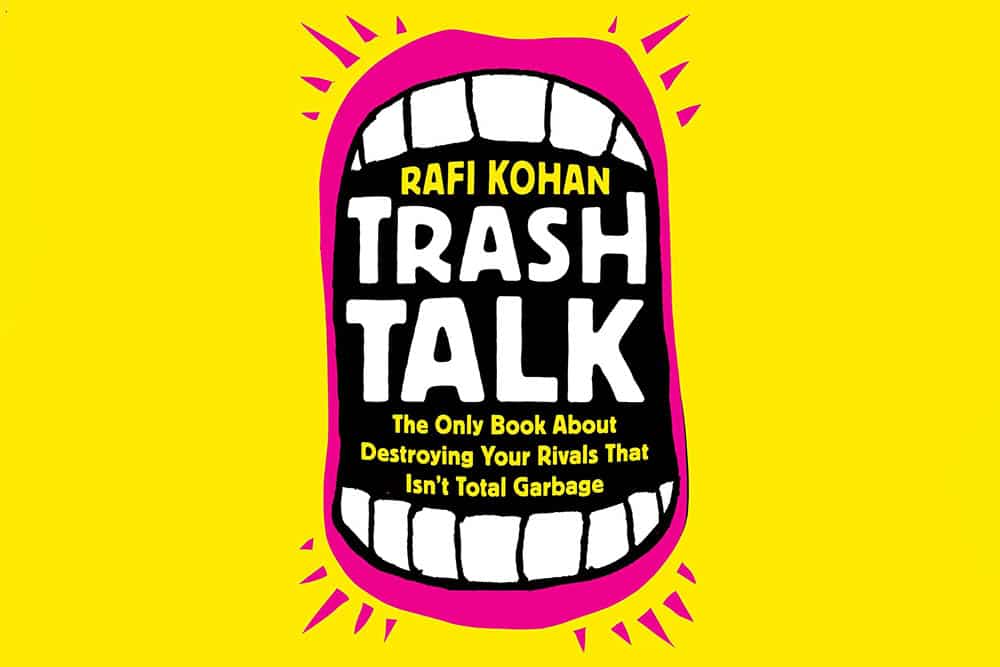
Despite being a long-time characteristic of team sports, the phenomenon of trash talk has largely gone unexamined. Editor and writer Rafi Kohan takes a deep dive into trying to understand this type of communication in Trash Talk: The Only Book About Destroying Your Rivals That Isn’t Total Garbage. His exploration is entertainingly written, but the book’s narrow focus and reluctance to engage more intensely with contentious questions make Trash Talk a less satisfying read than it could have been.
Starting with an appropriately absurd example of trash talk – a chant of “Fuck that sauce” at a UFC press conference involving an athlete that has his own line of hot sauces – Kohan delves into the origins of trash talk. He defines trash talk as “the language of incivility – ‘competitive incivility’, as some sociologists put it – which allows people to communicate when they’re going head-to-head…At its most basic level, when someone talks trash, that person is offering up a challenge that both acknowledges the fact of competition and seeks to further define its contours.” Kohan contextualizes trash talk as part of a centuries-old history of confrontational discourse, including long-standing cultures of verbal dissing in various social, ethnic, and racial groups.
He talks to former and current professional athletes, including legendary motor-mouths such as hockey player Sean Avery and football player Warren Sapp, about why they trash talk, how they decide what to say, who to say it to, and when to say it. Along the way, he also interviews academic experts and researchers on motivation, resiliency, psychology, and group dynamics to determine whether trash talk gives a player a competitive advantage. He visits military training programs that train attendees to endure extreme stress and interviews participants in comedy roast battles to understand the range of reactions to verbal attacks. He also explores techniques that targets of trash talk use to manage their responses.
The picture that emerges from Kohan’s investigations is that trash talk can be an effective psychological strategy, especially at elite levels of competition where mental toughness may have as much to do with success as physical training. However, to generate the intended impact, the trash talker has to know just how to get inside the head of their target, and how to unsettle them enough to affect their concentration and focus.
As indicated by the book’s in-your-face subtitle, Trash Talk is written in a breezy and captivating style that moves along at a lively pace. However, the appealing writing doesn’t overcome an obvious oversight: almost all Kohan interviewees are men. Former basketball player Cheryl Miller is the only female athlete whose voice is included with any regularity. She learned how to trash talk from playing basketball with her brothers.
There are professional basketball, soccer, and hockey leagues for women in the US and abroad – not to mention international and Olympic women’s teams and thousands of female athletes playing in collegiate, regional, and local leagues. So it’s truly puzzling why Trash Talk doesn’t explore trash-talking in women’s sports. Do women trash talk? If they do, is it different from men’s trash talk? Does trash talk affect female athletes differently than it does male athletes? Exploring such questions would have resulted in a more nuanced and in-depth understanding of trash talk and its role in competitive sport.
The lack of female voices in Trash Talk also relates to a more troubling issue. Beyond some consideration of the impact and use of the “n-word”, Kohan’s analysis never really gets to grips with the homophobia, sexism, and racism that often occur in trash talk. It’s not until the last chapter that Kohan acknowledges, “It’d be a mistake – if not outright disingenuous – to talk about sports (and the trash talk of sports) in isolation, as an exception to supposedly polite society. If anything, trash talk is nothing if not a reflection of our broader world, from its occasionally objectionable themes (like sexism and homophobia) to its eye-gouging ruthlessness.” He also briefly examines the difficulties athletes and officials face in controlling trash talk, especially in the heat of a competitive moment.
The point that sport reflects society is undeniably accurate, and Kohan is justified in making that point. Yet throughout the rest of Trash Talk, his discussion rarely considers why a recurring element of trash talk is terms like “pussy” and “bitch” that equate terms derogatorily associated with femininity that imply weakness or inferiority in an opponent.
It’s telling that in chronicling Sean Avery’s well-documented history of on- and off-ice trash-talking, Kohan largely overlooks the incident of trash-talking that caused the National Hockey League to suspend Avery briefly, and ultimately resulted in him being fired by his own team. He told reporters that players on other teams dating his ex-girlfriends were “falling in love with my sloppy seconds”. Avery’s objectification of women as possessions and as symbols of his sexual prowess was offensive enough that he was penalized by both his employers and his teammates. Yet Kohan’s analysis rarely engages with the deeper implications of imagery such as that used by Avery to insult or provoke.
Kohan admits that trash talk can cross the line into bullying and harassment and notes that it’s problematic to effectively regulate behavior when norms of what is and isn’t acceptable are continually evolving. But his discussion sidesteps the broader implications of trash talk. Sports leagues and teams promote inclusion and equality on and off the field. Yet these organizations implicitly accept norms of verbal discourse during games that frame women, immigrants, and the LGBTQ community as “others” or as lesser beings.
What message does that contradiction send to players and fans, especially those who belong to those “other” demographic groups? And what happens in society when this style of communication, used by highly visible and accomplished people, is accepted and celebrated? The analysis in Trash Talk doesn’t try to solve these conundrums; unfortunately, it doesn’t confront them, either.


![Call for Papers: All Things Reconsidered [MUSIC] May-August 2024](https://www.popmatters.com/wp-content/uploads/2024/04/all-things-reconsidered-call-music-may-2024-720x380.jpg)



